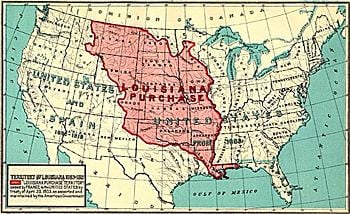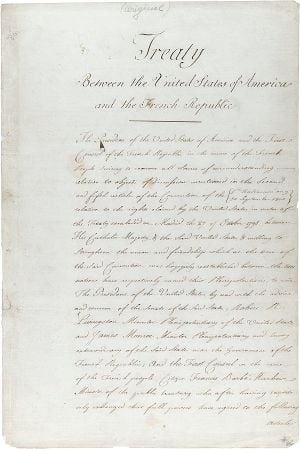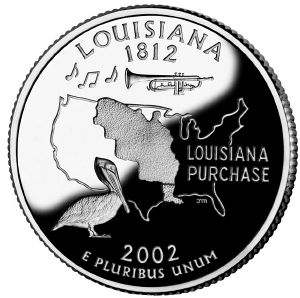Louisiana Purchase
 From Nwe
From Nwe 
Government Printing Office, 1912. Map No. 4.
The Louisiana Purchase was the acquisition by the United States of more than 530 million acres of territory from France in 1803, at the cost of about three cents per acre; fifteen million in total. Plus interest, the United States paid a total of $27,267,622 in exchange for the Louisiana territory (if adjusted for the relative share of GDP, this amount would equal approximately $707.6 billion in 2005,[1] or about $1,800 per hectare.)
The French territory of Louisiana included far more land than just the current state of Louisiana. The lands purchased contained parts or all of present-day Arkansas, Missouri, Iowa, Minnesota (west of the Mississippi River), North Dakota, South Dakota, Nebraska, New Mexico, northern Texas, Oklahoma, Kansas, the portions of Montana, Wyoming, and Colorado east of the Rocky Mountains, the portions of southern Manitoba, southern Saskatchewan and southern Alberta that drain into the Missouri River, and Louisiana on both sides of the Mississippi River including the city of New Orleans.
The land included in the purchase comprises 22.3 percent of the territory of the modern United States.
The purchase was an important moment in the presidency of Thomas Jefferson. At the time, it faced domestic opposition as being possibly unconstitutional.
Background
The city of New Orleans controlled the Mississippi River through its location; other locations for ports had been tried and had not succeeded. New Orleans was already important for shipping agricultural goods to and from the parts of the United States west of the Appalachian Mountains. Through Pinckney's Treaty signed with Spain on October 27, 1795, American merchants had "right of deposit" in New Orleans, meaning they could use the port to store goods for export. Americans also used this "right of deposit" to transport products such as flour, tobacco, pork, bacon, lard, feathers, cider, butter, and cheese. The treaty also recognized American rights to navigate the entire Mississippi River, which had become increasingly vital to the growing trade of their western territories. In 1798, Spain revoked this treaty which greatly upset Americans. In 1801, Spanish Governor Don Juan Manuel De Salcedo took over for Governor Marquess of Casa Calvo, and the right to deposit goods from the United States was restored.
Napoleon Bonaparte returned Louisiana to French control from Spain in 1800, under the Treaty of San Ildefonso (Louisiana had been a Spanish colony since 1762). However, the treaty was kept secret, and Louisiana remained under Spanish control until a transfer of power to France.
Americans were fearful that they would lose their rights of use to New Orleans. The Jefferson administration decided that the best way to assure long term access to the Mississippi would be to purchase the city of New Orleans and the nearby portions of Louisiana east of the Mississippi. Jefferson sent James Monroe and Robert Livingston to Paris to negotiate such a purchase. Their interest was only in the port, not in the broad swath of territory eventually included in the Louisiana Purchase which came as a surprise bonus.
Negotiation
Jefferson laid the groundwork for the purchase by sending Livingston to Paris in 1801, after discovering the transfer of Louisiana from Spain to France. Livingston was to pursue a purchase of New Orleans, but he was rebuffed by the French.
In 1802, Pierre Samuel du Pont de Nemours was enlisted to help negotiate. Du Pont was living in the United States at the time and had close ties to Jefferson, as well as to the political powers in France. He engaged in backchannel diplomacy with Napoleon, on Jefferson's behalf, during a personal visit to France. He originated the idea of the much larger Louisiana Purchase as a way to defuse potential conflict between the United States and Napoleon over North America.[2]
Jefferson disliked the idea: purchasing Louisiana from France would imply that France had a right to be in Louisiana. Jefferson also believed that presidents did not have the authority to engage in such a deal because it was not specified in the constitution and doing so would further erode states' rights by increasing federal executive power. On the other hand, he was aware of the potential threat that a neighbor like France could be for the young nation and was ready to go to war in case a strong French presence in the region was implemented. Charles Maurice de Talleyrand, likewise, was vehemently opposed to selling Louisiana since it would mean an end to France's secret plans for a takeover of North America.
Throughout this time, Jefferson had up-to-date intelligence on Napoleon's military activities and intentions in North America. Part of his evolving strategy involved giving du Pont information that was withheld from Livingston. He also gave intentionally conflicting instructions to the two. He next sent James Monroe to Paris in 1803. Monroe had been formally expelled from France on his last diplomatic mission, and the choice to send him again conveyed a sense of seriousness.
Napoleon was faced with the defeat of his armies in Saint-Domingue (present-day Republic of Haiti) where an expeditionary force under his brother-in-law Charles Leclerc was attempting to reassert control over a slave rebellion that threatened France's most profitable colony.
Political conflicts in Guadeloupe and in Saint-Domingue grew with the restoration of slavery on May 20, 1802, and the defection of leading French officers, like General Jean-Jacques Dessalines and Officer Alexandre Pétion in October 1802, within the context of an ongoing guerrilla war. The French had successfully deported Toussaint L'Ouverture to France in June 1802, but yellow fever was destroying European soldiers and claimed Leclerc in November.
Lacking sufficient military forces in America, Napoleon needed peace with the United Kingdom of Great Britain and Ireland to implement the Treaty of San Ildefonso and take possession of Louisiana. Otherwise, Louisiana would be an easy prey for the British or even for the Americans. Britain had breached its promise to evacuate Malta by September 1802 as stipulated in the Peace of Amiens, and in the beginning of the year 1803, war between France and Britain seemed increasingly unavoidable. On March 11, 1803, Napoleon decided to start building a fleet of barges to invade Britain.
These circumstances led Napoleon to abandon his plans to rebuild France's New World empire. Napoleon gave notice to his business minister, François de Barbé-Marbois, on April 10, 1803, that he was considering surrendering the Louisiana Territory to the United States. On April 11, 1803, just days before Monroe's arrival, Marquess de Barbé-Marbois, Napoleon's minister of the treasury, offered Livingston all of Louisiana instead of just New Orleans. President Jefferson had instructed Livingston to only purchase New Orleans. However, he was certain that the United States would accept such a large offer.

The American negotiators were prepared to spend $10 million for New Orleans but were dumbfounded when the entire region was offered for $15 million. The treaty was dated April 30, 1803, and was signed on May 2. On July 14, 1803, the treaty reached Washington, D.C. The Louisiana territory was vast, stretching from the Gulf of Mexico in the south to Rupert's Land in the north, and from the Mississippi River in the east to the Rocky Mountains in the west. Acquiring the territory doubled the size of the United States.
Finance
The finance of the purchase involved the British Barings Bank. In 1802, it helped finance the Louisiana Purchase, despite the fact that Britain was at war with France, and the sale had the effect of financing Napoleon's war effort. Technically, the United States did not purchase Louisiana from Napoleon; Louisiana was purchased from the Baring Brothers and Hope & Co. The payment for the purchase was made in United States bonds, which Napoleon sold to Barings at a discount of 87 1/2 per each $100. As a result, Napoleon received only $8,831,250 in cash for Louisiana. Alexander Baring, working for Hope & Co., conferred with the French director of the public treasury, François Barbé-Marbois, in Paris, then went to the United States to pick up the bonds and took them to France.
Domestic opposition
The American purchase of the Louisiana territory was not accomplished without domestic opposition. Jefferson's philosophical consistency was in question because of his strict interpretation of the Constitution. Many people believed he was being hypocritical by doing something he surely would have argued against with Alexander Hamilton.
The Federalists strongly opposed the purchase, favoring close relations with Britain over closer ties to Napoleon. The Federalists argued that the purchase was unconstitutional and that the United States had paid a large sum of money just to declare war on Spain. The Federalists also feared that the political power of the Atlantic seaboard states would be threatened by the new citizens of the west, bringing about a clash of western farmers with the merchants and bankers of New England.
A group of Federalists led by Massachusetts Senator Timothy Pickering went so far as to plan a separate northern confederacy, offering Vice President Aaron Burr the presidency of the proposed new country if he persuaded New York to join. Burr's relationship with Hamilton, who helped bring an end to the nascent northern secession movement, soured during this period. The animosity between the two men grew during the 1801 election and ended with Hamilton's death in a duel with Burr in 1804.
Treaty signing
On April 30, 1803, the Louisiana Purchase Treaty was signed by Robert Livingston, James Monroe, and Barbé Marbois in Paris. Jefferson announced the treaty to the American people on July 4.
The United States Senate ratified the treaty with a vote of 24 to seven on October 20; on the following day, it authorized President Jefferson to take possession of the territory and establish a temporary military government. In legislation enacted on October 31, Congress made temporary provisions for local civil government to continue as it had under French and Spanish rule and authorized the president to use military forces to maintain order. Plans were also set forth for a mission to explore and chart the territory, which would become known as the Lewis and Clark Expedition.
France then turned New Orleans over to the United States on December 20, 1803. On March 10, 1804, a formal ceremony was conducted in St. Louis to transfer ownership of the territory from France to the United States of America.
Effective on October 1, 1804, the purchased territory was organized into the Orleans Territory (most of which became the state of Louisiana) and the District of Louisiana, which was temporarily under the control of the governor and judges of the Indiana Territory.
Conflict with Spain
The Louisiana Purchase led to a dispute between the United States and Spain over the boundaries of the area the United States had bought. According to the Spanish, Louisiana consisted roughly of the west bank of the Mississippi River and the city of New Orleans. The United States, on the other hand, claimed that it stretched all the way to the Rio Grande and the Rocky Mountains, a claim unacceptable for Spain, as it would mean the loss of Texas and half of New Mexico, both Spanish colonies. The two nations also disagreed about the ownership of West Florida, a strip of land between the Mississippi and Perdido Rivers. The United States claimed this area was part of the purchase; Spain said that it was not, and east of the Mississippi only the city of New Orleans was part of the Louisiana Purchase. Spain also held that the entire Louisiana Purchase was illegal, because the Spanish treaty handing Louisiana to the French had stipulated the French were not allowed to hand it over to a third power, and also because Napoleon had not adhered to his part of the treaty (giving a kingdom in Italy to the brother-in-law of King Carlos IV).
In 1810, after a revolt in West Florida, the United States annexed the region between the Mississippi and Pearl rivers (known today as the Florida Parishes of Louisiana). In 1812, the Mobile District was annexed (the region between the Pearl and Perdido Rivers, which now forms the panhandles of Alabama and Mississippi). The matter was not fully settled until the signing of the Adams-Onís Treaty in 1819, in which Spain ceded all of Florida to the United States and the boundary between the Louisiana territory and the Spanish colonies was set along the Sabine, Red and Arkansas rivers and the forty second parallel.
Boundaries

When purchased, the boundaries of "Louisiana" were not defined, and the land itself was generally unknown. In particular, not wanting to anger Spain, France refused to specify the southern and western boundaries.
The tributaries of the Mississippi were held as the boundaries. Estimates that did exist as to the extent and composition of the purchase were initially based on the explorations of Robert LaSalle.
If the territory included all the tributaries of the Mississippi on its northern side, the northern reaches of the purchase extended into the equally ill-defined British possession—Rupert's Land of British North America, now part of Canada. The purchase originally extended just beyond the fiftieth parallel. However, territory north of the forty-ninth parallel was ceded to the United Kingdom in 1818 in the Red River Cession.
The eastern boundary of the Louisiana Purchase was the Mississippi River, from its source to the thirty-first parallel; the source of the Mississippi was then unknown, but is now known to be Lake Itasca in Minnesota. The eastern boundary below the thirty-first parallel was unclear; the United States claimed the land as far as the Perdido River; Spain claimed the border of its Florida Colony remained the Mississippi River. The Treaty with Spain of 1819 resolved the issue. Today, the thirty-first parallel is the northern boundary of the western half of the Florida Panhandle, and the Perdido is the boundary between Florida and Alabama.
The purchase extended westward to the Rocky Mountains. The southern boundary of the Louisiana Purchase was initially unclear; the Adams-Onís Treaty of 1819 began to lay down official dividing lines.
Notes
- ↑ The relative value in U.S. Dollars - Economic History Services. Retrieved June 25, 2007.
- ↑ Marc Duke, The du Ponts: Portrait of a Dynasty, Saturday Review Press, 1976, pp. 77-83.
References
ISBN links support NWE through referral fees
- Fleming, John J. The Louisiana Purchase. Hoboken, NJ: Wiley, 2003. ISBN 978-0471267386
- Kastor, Peter J. The Louisiana Purchase: Emergence of an American Nation. Washington, DC: CQ Press, 2003. ISBN 978-1568027067
- Kukla, Jon. A Wilderness so Immense: The Louisiana Purchase and the Destiny of America. New York: Random House, 2003. ISBN 978-0375408120
Credits
New World Encyclopedia writers and editors rewrote and completed the Wikipedia article in accordance with New World Encyclopedia standards. This article abides by terms of the Creative Commons CC-by-sa 3.0 License (CC-by-sa), which may be used and disseminated with proper attribution. Credit is due under the terms of this license that can reference both the New World Encyclopedia contributors and the selfless volunteer contributors of the Wikimedia Foundation. To cite this article click here for a list of acceptable citing formats.The history of earlier contributions by wikipedians is accessible to researchers here:
- Louisiana Purchase history
The history of this article since it was imported to New World Encyclopedia:
- History of "Louisiana Purchase"
Note: Some restrictions may apply to use of individual images which are separately licensed.
↧ Download as ZWI file | Last modified: 02/03/2023 20:07:36 | 49 views
☰ Source: https://www.newworldencyclopedia.org/entry/Louisiana_Purchase | License: CC BY-SA 3.0
 ZWI signed:
ZWI signed: KSF
KSF